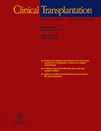Magnetic resonance cholangiopancreatography for the accurate diagnosis of biliary complications after liver transplantation: comparison with endoscopic retrograde cholangiography and percutaneous transhepatic cholangiography – long-term follow-up
Conflict of interest: None.
Abstract
Katz LH, Benjaminov O, Belinki A, Geler A, Braun M, Knizhnik M, Aizner S, Shaharabani E, Sulkes J, Shabtai E, Pappo O, Atar E, Tur-Kaspa R, Mor E, Ben-Ari Z. Magnetic resonance cholangiopancreatography for the accurate diagnosis of biliary complications after liver transplantation: comparison with endoscopic retrograde cholangiography and percutaneous transhepatic cholangiography – long-term follow-up.Clin Transplant 2010: 24: E163–E169. © 2010 John Wiley & Sons A/S.
Abstract: Biliary complications after liver transplantation remain a serious cause of morbidity and mortality. Direct invasive cholangiographic techniques, endoscopic retrograde cholangiography (ERCP) or percutaneous transhepatic cholangiography (PTC), have procedure-related complications. Magnetic resonance cholangiopancreatography (MRCP) is non-invasive, safe, and accurate. The aim of this study was to evaluate MRCP in detecting biliary complications following liver transplantation and comparing findings with ERCP and PTC. Twenty-seven consecutive liver transplant recipients who presented with clinical and biochemical, ultrasonographic, or histological evidence of biliary complications were evaluated with MRCP. Patients were followed up for a median period of 36 months. The presence of a biliary complication was confirmed in 18 patients (66.6%): anastomotic biliary stricture in 12 (66.6%); diffuse intrahepatic biliary stricture in 5 (27.7%): ischemic (n = 3), recurrence of primary sclerosing cholangitis (n = 2), and choledocholithiasis in one. In nine patients (33.3%), MRCP was normal. Six patients underwent ERCP, and eight PTC. There was a statistically significant correlation between the MRCP and both ERCP and PTC (p = 0.01) findings. The sensitivity and specificity of the MRCP were 94.4% and 88.9%, respectively, and the positive and negative predictive values, 94.4% and 89.9%, respectively. MRCP is an accurate imaging tool for the assessment of biliary complications after liver transplantation. We recommend that MRCP be the diagnostic imaging modality of choice in this setting, reserving direct cholangiography for therapeutic procedures.




